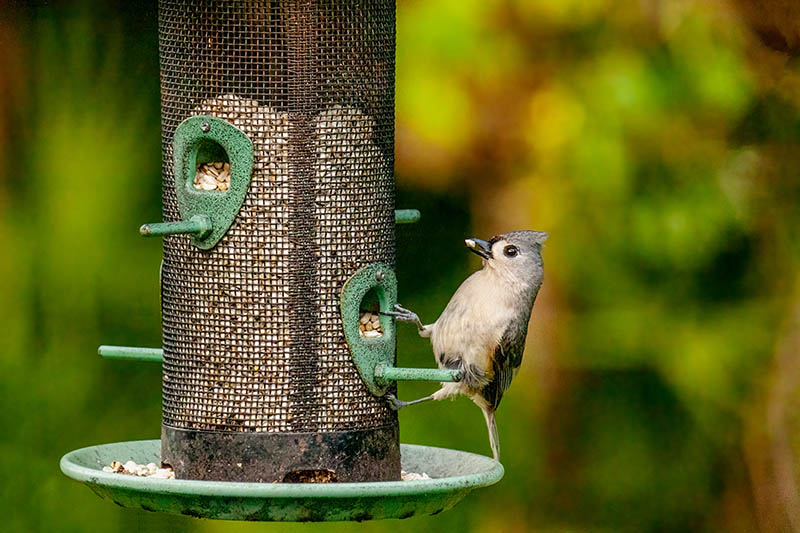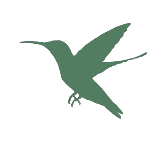What Does a Titmouse Eat? 10 Common Foods
Last Updated on

Insects make up about two-thirds of a titmouse’s diet.1 But if you’re trying to attract a titmouse to your yard, that won’t do much for you.
So, here, we focus on the other third of a Titmouse‘s diet. You can fill up your feeders with these great foods, and if there are titmice around, you should be able to spot them swoop down for a bite to eat!
While a titmouse primarily eats insects like spiders, beetles, ants, wasps, caterpillars, and snails, they’ll supplement their diets with seeds and other things during the leaner winter months.

Top 10 Foods to Attract a Titmouse
1. Sunflower Seeds

| Effectiveness: | High |
| Cost: | Low |
Tufted titmice prefer to go after the largest seeds possible, and few seeds are as large or as affordable as sunflower seeds. These can help improve the chances of attracting titmice.
Just keep in mind that these large seeds can also attract birds like crows to your yard.
2. Mealworms

| Effectiveness: | High |
| Cost: | Low |
Titmice prefer insects, and if they can’t catch live insects, why not give them the next best thing? Mealworms can fit in small feeders that only small birds can access, so you don’t have to worry about large intruders coming in and scaring everyone else away.
However, mealworms are more expensive than large seeds, so if you’re successful with attracting birds with them, you’ll end up spending more in the long run.
3. Peanuts

| Effectiveness: | High |
| Cost: | Low |
Peanuts are large seeds that do a great job of attracting titmice, as long as there aren’t too many larger birds coming in to take them.
Given the choice between smaller seeds and peanuts, a titmouse will almost always go for the peanuts. Of course, a larger bird will typically make this same decision.
4. Safflower

| Effectiveness: | Low |
| Cost: | Low |
Safflower is extremely small, so you can put it in small bird feeders that large birds can’t feed from. This makes it a great choice to attract finches and other small birds. It’s not a titmouse’s favorite food, but if they can’t find anything else around, they’ll go for it, and it won’t cost you an arm and a leg to restock.
5. Suet

| Effectiveness: | Low |
| Cost: | High |
Suet is small birdfeed that does a great job of attracting finches and other small songbirds. It’s not a favorite for the titmouse, but during lean times, they’ll take whatever they can get. The advantage of suet is that you can put it in small feeders, so you don’t have to worry about large birds.
6. Blueberries

| Effectiveness: | High |
| Cost: | High |
If you’re looking for a natural way to attract titmice, one great thing that you can do is to plant a blueberry bush or two. Titmice love blueberries, and the good thing is that with a couple of bushes, you don’t need to worry about restocking them.
Even better, whatever the titmice don’t eat, you can harvest and have for yourself!
7. Mulberries

| Effectiveness: | High |
| Cost: | High |
Mulberries are plants that you can put into your yard to try to attract titmice. They love mulberries, and you don’t need to worry about restocking them.
However, you can’t just have a fresh supply ready to go with a mulberry bush. Still, it’s a great choice to try to get titmice to come to visit or even nest in your yard.
8. Virginia Creeper

| Effectiveness: | Low |
| Cost: | Low |
The Virginia Creeper isn’t the favorite food of a titmouse, but it’s easy to grow and it’s something that they’ll forage on when the pickings are slim. It’s a vine-style plant that can grow in many places and adds an aesthetic appeal to your yard in addition to attracting the occasional titmouse.
9. Pine Seeds

| Effectiveness: | Low |
| Cost: | Low |
The titmouse will always go after the largest seeds available. But when there’s not much around, they’ll chow down on pine seeds. These seeds are also small, which is perfect for small feeders, and they don’t cost much to purchase.
10. Nyjer® Seeds

| Effectiveness: | Low |
| Cost: | High |
Nyjer seeds are some of the most expensive seeds that you can purchase for feeders, but that doesn’t mean they’re the best for attracting every type of bird. They’re extremely small, though, which lets you get small feeders. This severely limits the types of birds that can eat from them, but the titmouse is small enough to pull it off. If they can get large seeds, they’ll go that route, but if they can’t, Nyjer seeds are still good.
Tips for Attracting Titmice to Your Yard
If you’re trying to get titmice into your yard, there are a few different things that you can do. First, you can put out a few different feeders with the foods highlighted here.
Second, put up a bird bath. Not only will they have access to the food that they need during the winter months, but they’ll also have water. Finally, put up a few nest boxes for them.
This completes the trifecta for the titmouse. They can have food, water, and shelter all in one area, making it the perfect place for them to call home. Just know that they’re not the only type of bird looking for these conditions, so you might attract other kinds of birds in the process.

Conclusion
Now that you know more about what titmice like to eat and how to attract them to your yard, it’s up to you to do the necessary work to get them. It might be a bit of a process, but when you have a few titmice making your backyard their home, their frequent appearances will make the work worth it.
Featured Image Credit: Light and Vision, Shutterstock
About the Author Robert Sparks
Robert’s obsession with all things optical started early in life, when his optician father would bring home prototypes for Robert to play with. Nowadays, Robert is dedicated to helping others find the right optics for their needs. His hobbies include astronomy, astrophysics, and model building. Originally from Newark, NJ, he resides in Santa Fe, New Mexico, where the nighttime skies are filled with glittering stars.
Related Articles:
10 Types of Hummingbirds in Arkansas (With Pictures)
8 Types of Hummingbirds in Nebraska (With Pictures)
5 Types of Hummingbirds in Idaho (With Pictures)
3 Types of Hummingbirds in Mississippi (With Pictures)
8 Types of Hummingbirds in Kansas (With Pictures)
5 Types of Hummingbirds in West Virginia (With Pictures)
5 Types of Hummingbirds in Ohio (With Pictures)
Where Do Nuthatches Nest? Nuthatch Nesting Habits Explained
